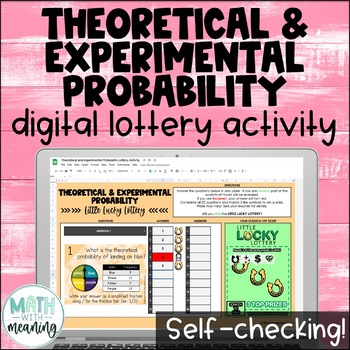Theoretical and Experimental Probability Self-Checking Digital Activity
- PDF
- Google Apps™
- Internet Activities

What educators are saying
Description
Looking for a fun self-checking activity to practice working with theoretical and experimental probability? Students will use spinners and frequency tables to answer 20 questions in this engaging, no-prep digital lottery activity!
This activity requires students to find the theoretical and experimental probabilities of simple events and to use theoretical probabilities to make predictions. Please view the preview file to make sure that this activity is appropriate for your students.
In this activity, students will answer questions in order to scratch off their digital lottery ticket. As they correctly answer questions, more of the scratch-off card is revealed. After correctly answering all the questions, students check over their card to see if it is a winner.
In theory, there is a 10% chance of each student winning; however, this amount is subject to random selection and the actual data may not match the theoretical probability. Winning cards are not guaranteed until all questions are answered correctly. Just for fun, I suggest providing a small prize to any student who reveals a winning card.
Also, please be aware when assigning this activity: if students close and reopen this file, they will get a new lottery ticket. For this reason, if assigning for homework, ask your students to take a screenshot of their ticket if they have a winning card.
This product includes the following:
- A link to the activity on Google Sheets
- Detailed directions for how to share the activity with students
- An optional recording sheet
- Answer key
Please note that this activity is NOT editable. The text, problems, and images are not able to be changed.
***************************************************************************
You May Also Like:
- Better Buy Taco Tuesday DIGITAL Drag and Drop Activity
- Two-Step Equations Matching Activity
- Combining Like Terms (With Integers) Scavenger Hunt Activity
- Solving Inequalities Matching Activity
- Integer Operations Activity Bundle
***************************************************************************
How to get TPT credit to use on future purchases:
- Go to your My Purchases page. Beside each purchase you'll see a Provide Feedback button. Simply click it and you will be taken to a page where you can give a quick rating and leave a short comment for the product. Each time you give feedback, TPT gives you feedback credits that you use to lower the cost of your future purchases. I really appreciate your feedback, as it helps me to design resources that meet the needs of my customers!
Be the first to know about my new discounts, freebies and product launches:
- Look for the green star next to my store logo and click it to become a follower.
- New products are discounted for the first 24 hours!
Connect with me!
- Check out my blog for classroom ideas and tips!
- Follow me on Instagram to see daily life in my middle school math classroom!
©Google LLC All rights reserved. Google Drive, Google Slides, and Google Forms are trademarks of Google LLC.





